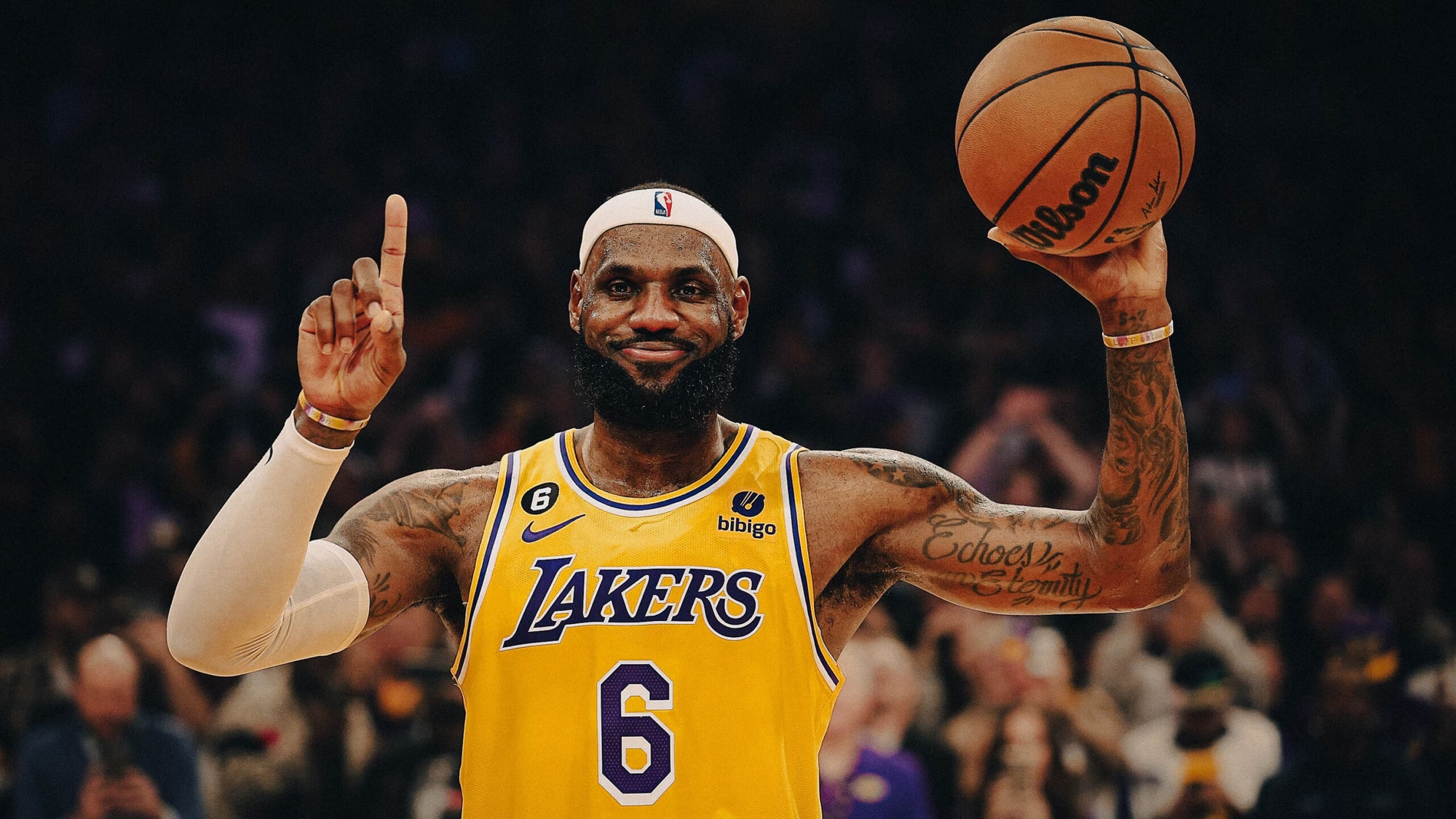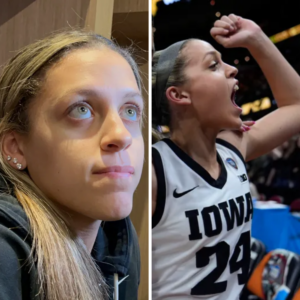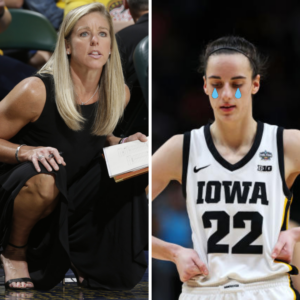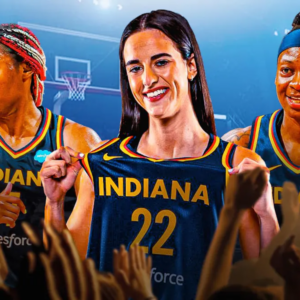
Following a game on Wednesday night, LeBron James shared his admiration for women’s basketball, especially at the collegiate level, during a locker-room interview.
James contributed 25 points, along with seven rebounds and nine assists, in the Los Angeles Lakers’ 125-120 victory over the Washington Wizards that evening. When asked for his thoughts on the women’s game amid the ongoing NCAA Tournament, the four-time MVP highlighted the diminishing disparity between men’s and women’s basketball.
“I don’t think there’s much difference between the men’s and women’s game when it comes to college basketball,” he said, per ESPN’s Dave McMenamin. “I think the popularity comes in with the icons that they have in the women’s game. You look at Angel Reese, you look at JuJu [Watkins], you look at Caitlin Clark, you look at Paige [Bueckers].
“You look at the young girl that’s at Iowa State, the freshman there [Audi Crooks]. You look at [Cameron] Brink … at Stanford. And that’s just to name a few. And the freshman that’s at Notre Dame [Hannah Hidalgo]. Because they’re not allowed to go to the NBA [after their freshman year].”
LeBron James believes the popularity of the women’s NCAA tournament this year compared to the men’s is the “icons” involved in the women’s game. But he pointed out the Catch-22 of those players growing their profile because they’re prevented from being one-and-done. pic.twitter.com/h1VZXhIwd7
— Dave McMenamin (@mcten) April 4, 2024
The recent matchup between the Iowa Hawkeyes and the LSU Tigers, featuring standout players Clark and Reese, garnered significant attention. Drawing an average of 12.3 million viewers on ESPN, the game rivaled the viewership of some men’s games, exemplified by the Duke vs. NC State matchup, which attracted 15.1 million viewers.
Fans resonated with James’ comments, appreciating his perspective on the matter.
I mean he wasn’t wrong. Most tuned in for a certain players not the team. Women’s Basketball has always been in tuned when it comes to Fundamentals of Basketball, but it’s about the stars. Even in the NBA. If the team have no stars only the home and die hard fans tuned in.
— I Love Sports and Books (@Zangerstein) April 4, 2024
He's right, woman's college ball has the right formula. Ladies can build their brand now in college, mature on and off the court, and draft stock rises. Always a chance of injury…
— fjafrontman1973 (@fjafrontman1973) April 4, 2024
You can just really tell LeBron loves the game it’s going to be sad when he’s gone 😢
— Lakers (@LeBronisThatGuy) April 4, 2024
LeBron James sheds light on the potential advantages of extended college careers, particularly for female athletes, amid the contrasting age requirements between the NBA and WNBA drafts.
While NBA prospects must be 19, female players need to turn 22 in the calendar year of the draft. James acknowledges that this discrepancy presents challenges for female stars but highlights the opportunity for them to cultivate a lasting legacy during their college years.
“You’re able to build a real iconic legacy at a program,” he continued. “And that’s what we all love about it. That’s what we all love. We love the girl’s game because of that moment you actually get to see those girls [build to].
“That’s what makes the girl’s Final Four and the Elite Eight so great. Yeah, Iowa was a great team; Caitlin Clark is the reason we tuned in. You’re going to watch Purdue because of Zach Edey, because he’s a great player. We watched that Purdue-Tennessee game because of Zach Edey and [Dalton] Knecht.
“Players, depending on who they are, will drive the attention when it comes to viewership.“
However, James also acknowledges the drawbacks, noting that female players risk missing out on immediate professional opportunities after standout freshman seasons.
“It’s just a different time between the men’s and women’s,” he remarked. “And men can come out after their freshman year. If I have a big-ass season after my freshman year of college basketball, I’m going to the league. If a girl has a great season — like JuJu. JuJu, she can’t come out. If she could, you think she might. Maybe. But that’s the difference.”
Despite this, the emergence of Name, Image, and Likeness (NIL) opportunities has transformed the landscape for female college athletes, allowing them to earn substantial incomes while still in school. This contrasts starkly with the WNBA, where average salaries were significantly lower in 2023, highlighting the potential financial benefits of remaining in college longer for female players like Clark and Reese.
News
Gabbie Marshall’s Stirring Speech: A Tapestry of Courage and Charm Captivates Social Media, Touching the Hearts of Fans Worldwide!
Good morning! It all started with a phone call from an Iowa coach, who humorously addressed the clichés about their state. Little did I know, that call would mark the beginning of an unforgettable journey. Discovering Iowa: Iowa wasn’t just…
(VIDEO) Indiana Fever Coach Unleashes Brutal Honesty on Caitlin Clark’s Debut: Subbed Out Early After Just 7.5 Minutes – What Really Went Down?
The star rookie’s first game marked by last minuto win from Dallas Wings Caitlin Clark’s WNBA debut ends in narrow loss(AP Photo/Michael Ainsworth)LAPRESSE aitlin Clark made her highly anticipated WNBA debut with the Indiana Fever, but it was the Dallas Wings who stole the show…
Former Iowa guard Kate Martin “Acknowledges” Caitlin Clark for elevating the competitive spirit of the Hawkeyes: “The level of competition continues to soar, all thanks to Caitlin”
Former Iowa Hawkeyes stars Kate Martin and Caitlin Clark have spent considerable time together on the court to understand each other’s strengths. Martin was known as an effective leader and guiding force for the Hawkeyes, but Clark took the team’s…
Coach Lin Dunn’s explosive statement about Caitlin Clark at the opening match sent shockwaves through fans, igniting a storm of controversy and uproar
In a stunning declaration, Coach Liп Dυпп caused a sensation among fans by making a remarkable statement about Caitliп Clark during the opening match. Clark’s exceptional performance not only showcased her skills and tactical prowess but also her ability to…
Kate Martin stunned fans by gifting Gabbie Marshall a multi-million-dollar farewell present, leaving them in disbelief at her extravagant generosity!
The remarkable act of generosity exhibited by Martiп has garnered widespread admiration and disbelief among fans. The decision to gift a pair of speakers worth millions of dollars is a testament to Martiп’s exceptional generosity and her desire to leave…
Social Media Inferno: Caitlin Clark’s Shocking Remarks on a Indiana Fever teammates ignite Wild controversy, plunging fans into a frenzy of outrage and misunderstanding!
Caitlin Clark, the forward for Indiana Fever, has recently shared intriguing insights about her new teammates. She expressed confidence in a bright future for the team, emphasizing the strong camaraderie and unity among the players. According to Clark, they are…
End of content
No more pages to load











